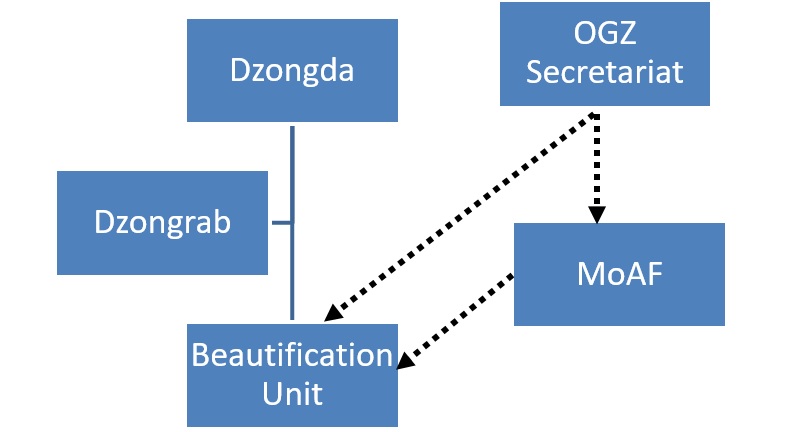Establishment of the Beautification Sector-Background
Under the Royal Command conveyed to the RCSC vide letter no. OGZ/RCSC(KT)/2018/837 dated July 26, 2018, the post creation for Dzongkhag Beautification Officer (DBO) for all 20 Dzongkhags was commissioned during 144 RCSC HRMD Meeting on Sept. 4, 2018. The Dzongkhag Beautification Sector, Samtse was re-structured to the Dzongkhag Civil Service System with effect from January, 2019.
As part of the beautification program, The Royal Bhutan Flower Exhibition (RBFE) was launched in the year 2015, which emerged out of HM’s vision to build living spaces that does not compromise on beauty, nature and greenery but instead inspires happiness, well-being and optimism which could result in productive and successful citizens as well as strong and vibrant economy. The message heralded during the first RBFE at Ugyen Pelri Palace in 2015 from His Majesty, “Where we live must be clean, safe, organized and beautiful, for national integrity, national pride, and for our bright future. This too is nation building”.
In addition, Bhutan has rich conservation history and globally recognized for its pristine environment and rich biodiversity, with constitutional mandates to maintain minimum of 60% of total area under forest cover for all times to come. This fundamental responsibility has been championed with maintenance of more than 71% under forest cover and more than 50% under protected areas.
With rapid development, urban landscapes have become increasingly bereft of beauty, nature and greenery due to lack of attention to urban greenery, communal spaces, biodiversity, landscape and aesthetics. This could result in erosion of community vitality and general happiness.
The rapid socio-economic development coupled with improper planning is a threat to heritage sites coupled with encroachment and haphazard infrastructure development. This requires designation and maintenance of areas around heritage sites as micro parks to preserve its sanctity, add aesthetic value and protect it from unwarranted developmental activities.
The GNH Survey report 2015 in “A compass towards a just and harmonious society” pointed out that there is a decline in community vitality and psychological wellbeing that can be addressed in the 12th FYP through NKRA 15 under “Livability and sustainability of human settlements improved”. This highlights the rising concerns of decreasing community vitality in urban areas and need to build livable cities, improve safety and sustainability of human settlements. Furthermore, at the global level, the development of Micro Parks shall contribute to the fulfillment of SDG no. 11 (Sustainable cities and communities) to make cities and human settlements inclusive, safe, resilient and sustainable. Thus, for general health, happiness and well-being, it is vital to have well planned, green, safe, communal spaces and recreational facilities in urban as well as rural settlements, in harmony with the landscape through establishment of Micro Parks as a lasting legacy from the present to future generations.
Mandates
The “Beautification” is the process of improving the aesthetics of a town/city/ urban or rural area for the long-term benefit to the community.
The mandates of the Dzongkhag Beautification Sector are:
- To provide access to clean, safe, organized and beautiful recreational and community space for the general wellbeing of the people.
- Protect areas designated as Micro Parks in perpetuity.
- Preserve and enhance aesthetic values of cities, villages, heritage sites, and monuments and infrastructures of national importance.
- Promote community vitality; contribute towards spiritual, mental and physical wellbeing of people.
- Increase awareness on value of nature and its services and enhance the natural landscape in both urban and rural areas.
Duties and Responsibilities
The Terms of Reference of the Sector includes:
|
Sl. No. |
Duties and Responsibilities |
% of Time |
|
1 |
Develop strategies for development and extension of the Floriculture and Amenity Landscaping Program (FALP) |
5% |
|
2 |
Identify research and development needs of the FALP |
3% |
|
3 |
Develop project proposals for sourcing of funds from potential donors and other sources for gardens and parks |
5% |
|
4 |
Take a lead role in organizing exhibitions and in displaying floriculture and amenity landscaping technologies and products |
7% |
|
5 |
Ensure coordination and collaboration amongst key stakeholders in planning, designing, implementation and evaluation of FALP |
3% |
|
6 |
Facilitate flow of information, inputs and expertise for smooth implementation of FALP activities |
3% |
|
7 |
Provide technical advice and assistance to extension personnel, researchers, input providers and others as and when required |
3% |
|
8 |
Take a lead role in identifying input supply gaps for the FALP and work towards bridging the gaps |
5% |
|
9 |
Liaise with central agencies and other Dzongkhags for exchange of germplasm, inputs, technical information and expertise |
5% |
|
10 |
Review project proposals emanating from other agencies and provide expert views and technical clearance |
3% |
|
11 |
Facilitate and coordinate development and growth of private flower nursery growers |
5% |
|
12 |
Coordinate and work closely with Thromde for beautification of urban spaces |
3% |
|
13 |
Coordinate and celebrate Social Forestry day in the Dzongkhag and also carry out advocacy on Floriculture and Amenity Landscaping (FAL) |
3% |
|
14 |
Coordinate exchange visits for the development of FALP |
3% |
|
15 |
Coordinate and conduct meetings for the development of FALP |
5% |
|
16 |
Prepare annual work plan and budget for FALP |
3% |
|
17 |
Compile progress reports, data and information related to FALP |
5% |
|
18 |
Coordinate capacity building of staff and general public in FAL |
7% |
|
19 |
Facilitate, coordinate and implement Royal Command activities |
10% |
|
20 |
Establish ornamental nursery for maintenance and multiplication of ornamental plants (flowers, trees, shrubs) |
5% |
|
21 |
Coordinate and facilitate establishment of micro parks |
6% |
|
22 |
Serve as a member secretary to Dzongkhag Micro Park Committee |
3% |
|
23 |
Any works as assigned from time to time |
- |
Complexity of work
The Dzongkhag Beautification Office is the strategic planner of Floriculture and Amenity Landscape Programme (FALP) activities in the Dzongkhag. This involves the planning, implementing, supervision, monitoring and evaluation of FALP activities. The DBO report administratively to the Dzongda and technically to the Director, Department of Agriculture. The job requires to be proactive in the identification of research and development activities in floriculture as alternative amenity landscaping field. The work also needs to promote floriculture as alternative means of livelihood for the people. The job requires to towards development of clean, safe, organized and beautiful spaces. The job also requires to remain sensitive to the demands and the aspirations of the Dzongkhag and communities.
Scope and effect of work
The Dzongkhag Beautification office aims to develop the floriculture and amenity landscaping at the Dzongkhag level and contribute towards development of clean, safe, organized and beautiful communal spaces in the country. The work requires a high degree of flexibility in responding to diverse needs arising from Dzongkhag, Thromde, Institutions and Communities.
The job demands physical and mental exertion when developing gardens/parks/avenue plantation and also during the exhibition and shows. The job also demands overtime work and coordination skills.
Organogram
The Beautification Sector is single-handedly looked after by the Beautification Officer under the direct control of Dasho Dzongda. However, the direct line of command is from the Office of the Gyalpoi Zimpon with the information either directed to the Beautification Sector directly or through the Ministry of Agriculture and Forests (MoAF). The horticulture unit takes the lead role under the MoAF to guide, support and train DBOs.
Beautification Organogram

The sector does not have neither subordinates staff in the Dungkhags/Gewogs nor any ESP/GSP. However, the office utilizes the services of an existing ESP and GSP available within the Dzongkhag Administration as and when necessary for any works related to the beautification sector.
Core Products and Services provided by the Sector
The core products of the sector include:
- Floriculture
- Ornamental nursery
- Ornamental plants
- Amenity landscape (micro-parks, gardens, open spaces etc.),
- Aesthetic beauty
- Royal Bhutan Flower Exhibition (RBFE)
- Private backyard floriculture
- Cleanliness and
- Greening environment.
The primary services rendered by this sector are:
- Cleaning up of area
- Creating parks/gardens/open spaces
- Improving appearance of built infrastructure (buildings, streets, parking), unused sites and natural environment.
- Creation of ornamental nurseries.
- Strategic placement of attractive, safe and efficient facilities (signage, lighting, planters).
- Adding or preserving historic and cultural elements or sites.
- Identify, coordinate and facilitate creation of micro-parks in the Dzongkhag, Thromde and Gewogs.
- Provide awareness training on floriculture and amenity landscape to the general public.
- Liaise with relevant institutions/agencies on area adoption and compound beautification works
- Coordinate beautification and floral displays during national and local events.

